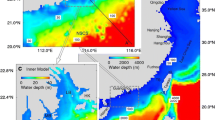Abstract
CTD data on standard levels collected during July and December in 1998 and the cubic spline interpolating method were used to study the characteristics of the transition layer temperature and salinity. The thermocline undergoes remarkable seasonal variation in the South China Sea (SCS), and especially in the region of the north shelf where the thermocline disappears in December. The thermocline is stronger and thicker in July than in December. There is no obvious seasonal variation in the halocline. Due to the upper Ekman transport caused by monsoon over the SCS, the thermocline slopes upward in July and downward in December from east to west in the northern SCS. The characteristics of the thermocline and halocline are influenced by local eddies in the SCS. The Zhujiang diluted flow influences significantly the SCS shelf's halocline.
Similar content being viewed by others
References
Huang Qizhou, Wang Wenzhi, Li, Y.S., 1992. General situations of the current and eddy in the South China Sea.Advance in Earth Sciences 7(5): 1–9 (in Chinese with English abstract)
Li Peiliang, Qi Jianhua, Fang Xinhua, 2000. The characteristics of the seawater transition layer in the investigated ara of Nansha Islands in Nov. 1997.Transactions of Oceanology and Limnology 1: 1–7. (in Chinese with English abstract)
Liu Qinyu, Yang Haijun, Wang Qi, 2000. Dynamic characteristics of seasonal thermocline in the deep sea region of the South China Sea.Chin. J. Oceanol. Limnol. 18(2): 104–109.
Liu Yonggang, Yuan Yaochu, Su Jilan et al., 2000. The gyres in the South China Sea in the summer of 1998.Chinese Science Bulletin 55(12): 1252–1259. (in Chinese)
Qiu Zhang, Huang Xizhou, 1994. Analysis of the space-time distribution of the thermoline in the area of Nansha Islands. Proceedings of the Physical Oceanography in the region of the Nansha Islands. Ocean Press, Beijing, P. 81–113. (in Chinese)
Qiu Zhang, Xu Xizhen, Long Xiaomin, 1996. The characteristics of the seawater transition layer in the investigated area of the Nansha Islands in Septembert. 1994.Tropic Oceanology. 15(2): 61–67. (in Chinese with English abstract)
Shaw, P.T., 1996. Winter upwelling of Luzon in the northeastern South China Sea.J. Geophys. Res. 101(C7): 16435–16448.
Su Jilan, Xu Jianping, Cai Shuqun et al., 1999. Gyres and Eddies in the South China Sea. Onset and evolution of the South China Sea monsoon and its interaction with the ocean. China Meteorological press, Beijing, P. 272–279.
Xu Xizhen, Qiu Zhang, Long Xiaomin, 1993. The radical characteristics and the one dimensional calculated pattern of the South China Sea thermocline.Oceanologia et Limnologia Sinica 24(5): 494–502. (in Chinese with English abstract)
Author information
Authors and Affiliations
Additional information
Project No. 49906001 supported by the NSFC; the CTD data were provided by ‘Monsoon Experiments in South China Sea’ Project (G1999043805).
Rights and permissions
About this article
Cite this article
Peiliang, L., Juncheng, Z., Lei, L. et al. Characteristics of the transition layer in the South China Sea in 1998. Chin. J. Ocean. Limnol. 21, 27–33 (2003). https://doi.org/10.1007/BF02842758
Received:
Accepted:
Issue Date:
DOI: https://doi.org/10.1007/BF02842758



